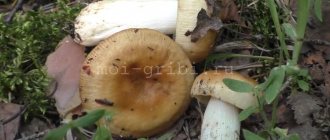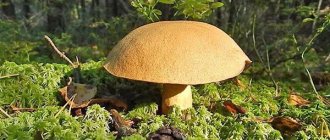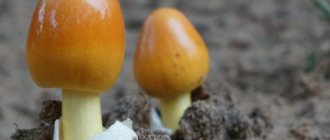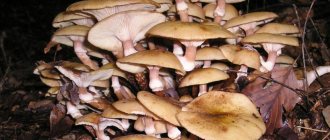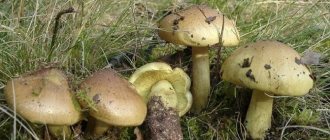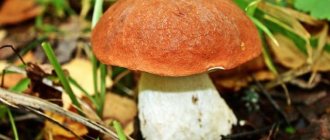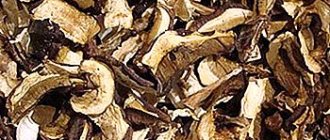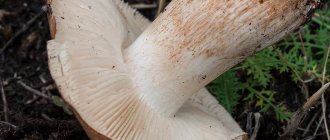What do purple mokrukha mushrooms look like?
Purple moth, also known as pine moth or yellowleg, belongs to the Boletaceae order and the Mokrukhov family, and has a fairly recognizable appearance.
The photo of the purple moth shows that its cap is relatively small, from 4 to 8 cm in diameter, at a young age it is round, convex and with a characteristic blunt tubercle in the middle, and in an adult it is spread out or even concave. The surface of the cap is smooth, in wet weather it becomes covered with a mucous coating, the color is very unusual, brownish-lilac or with a reddish wine tint. The bottom surface of the cap is covered with wide thin plates, pinkish-purple in young mushrooms, and dirty brown, sometimes almost black, in adults.
The leg of the purple moth is thin, rises up to 10 cm above the ground, is often curved and usually tapers slightly towards the base. The color of the leg is the same shade as the cap, but remains a little lighter. The structure of the stem is silky to the touch; often you can see the remains of a covering on it, especially in young fruiting bodies.
If you cut the purple mocha, the flesh of the cap will be dense and mauve, with a neutral smell and taste. The leg is lilac-red when cut, and yellow at the very base.
Appearance
The spruce fly's cap does not have a special appearance. Its color is gray and with small dark spots. Old mushrooms have a completely black cap. The cap itself has a diameter of 15 centimeters, but due to humidity it looks larger. The plates at the bottom of the cap are grayish in color, which also darkens with age of the mushroom. The leg color is white. At the base the color is bright yellow. A characteristic feature of the mushroom is its mucus, which covers both the entire cap and the stem. When the mucus dries, the cap becomes glossy and shiny. The skin can be easily removed. The cap and stem are connected by a thin blanket of mucus. The pulp of spruce fly is tender and does not darken when cut.
Where do pine moths grow?
Purple mokrukha is not the most common mushroom in Russia. However, you can see it throughout almost the entire country - in the middle zone, in the Caucasus and Crimea, even in Siberia. Most often, yellowlegs grows on calcareous soils in coniferous and mixed forests. It is sometimes found on hills, but usually forms a symbiosis with birch or pine trees.
Purple moth grows both singly and in groups. It is often found not far from boletus, as it chooses similar habitats.
Benefits and harm to the body
The popularity of purple mokrukha in cooking is due not only to its taste. Yellowlegs can provide great health benefits due to its valuable chemical composition. Its pulp contains the following substances:
- vitamins B2, B1 and E;
- ascorbic acid;
- vitamin PP;
- cellulose;
- a large amount of high-quality vegetable protein;
- amino acids;
- organic acids and enzymes;
- potassium and iron;
- calcium, phosphorus and manganese.
With good nutritional value, yellowleg is very low in calories and contains only 19 kcal per 100 g of pulp, so it is found in many diets.
Eating purple moth has a beneficial effect on the body because the product:
- strengthens the immune system and improves the functioning of the metabolic system;
- helps relieve inflammation and fight infections;
- has a calming and relaxing effect;
- has a positive effect on the muscular system;
- promotes cell renewal;
- improves the condition of skin and hair;
- has a good effect on blood vessels and protects the heart from the development of chronic diseases;
- strengthens memory and improves brain function.
Despite its many beneficial properties, purple mocha has some contraindications. First of all, it is not recommended for pregnant women and nursing mothers to eat it. Yellowlegs should not be offered to young children under 7 years of age; any mushroom pulp is poorly absorbed by their bodies due to its high protein content.
Advice! You should also avoid purple yellowlegs if you have an individual intolerance to mushrooms, or with chronic ulcers and pancreatitis. The protein-rich product can slow down digestion, so you should eat it with caution if you have frequent constipation.
Healing properties
Yellowlegged moth is the absolute champion in terms of the amount of nutrients and amino acids. It contains:
- Vitamin C. Its deficiency manifests itself in tooth loss, heart weakness, and fatigue. It strengthens the immune system and improves performance.
- Riboflavin. Its deficiency can cause eye diseases and hair loss. Vitamin B2 plays an important role in enriching cells with oxygen.
- Thiamine. This vitamin regulates metabolic processes, the functioning of the heart and blood vessels, and affects the activity of the nervous system.
- Vitamin E. Increases libido, promotes successful conception and pregnancy.
Traditional healers use this mushroom to prepare ointments that are used to treat neurogenic and common dermatitis. The product is made from alcohol.
The principle of preparing the medicine is the same as for the red fly agaric ointment:
- It is necessary to chop the caps of 10 mushrooms and place them in a 1 liter container.
- Then you should close it tightly with a lid and leave it in a warm place for 3 days.
- After the passed interval, the mokrukha must be filled with moonshine or alcohol to the top so that a layer of liquid of 1 cm forms above them.
- The container must be sealed again and left for a month.
The resulting composition is lubricated on the skin using a cotton pad. This should be done at night. The ointment is stored for no more than 3 years in a dark place.
False doubles
The purple fly has no poisonous or hazardous counterparts. But in the absence of experience, it can easily be confused with edible mushrooms of the same species.
Spruce fly
This mushroom is very similar in structure to the purple variety. His hat is also medium in size, first convex and then spread out, the leg reaches 12 cm in height and 2.5 cm in girth. But you can distinguish the spruce mushroom by the shade of its color; its cap is gray or gray-violet; it does not have an unusual wine tint.
In accordance with its name, spruce fly grows mainly in spruce forests and forms a symbiosis with spruce trees. You can eat it, but its taste is rather average.
Pink wee
Another variety similar to the photo of pine moth is the pink moth. Mushrooms are united by similar structural features - strong cylindrical legs, narrowed at the bottom, and convex caps at first, and later spread out caps. But the differences between the varieties are noticeable - the pink fly is much smaller and rarely exceeds 5 cm in diameter. In addition, its cap is bright pink when young, while on old fruiting bodies it has a slight yellowish tint and dark brown spots.
Pink moths grow in coniferous forests, mainly in the mountains, and are often found next to goats. The mushroom is not widespread and is quite rare. Like purple moth, it is classified as edible, but has a mediocre taste and requires peeling before consumption.
Kinds
| Purple moth (Chroogomphus rutilus) |
| The cap is 25–95 mm in diameter, young fruiting bodies have a cone-shaped shape with a drooping edge; as they grow, the shape changes to convex and flat and even funnel-shaped with a noticeable tubercle in the middle. The skin is bare, smooth, and with high humidity it becomes sticky and slimy. The color varies from yellow-brown to brown and wine red with a purple tint. |
| Tomentosweet (Chroogomphus tomentosus) |
| The cap is 25–100 mm in diameter, young fruiting bodies are hemispherical in shape; as they grow, the cap becomes convex and prostrate with a pronounced tubercle in the middle with a drooping edge. The skin is fibrous, dry, becomes slightly sticky when humidity increases, the color varies from different shades of ocher to yellowish-pinkish-brown. |
| Purple moth (Chroogomphus rutilus) |
| The cap is 25–95 mm in diameter, young fruiting bodies have a cone-shaped shape with a drooping edge; as they grow, the shape changes to convex and flat and even funnel-shaped with a noticeable tubercle in the middle. The skin is bare, smooth, and with high humidity it becomes sticky and slimy. The color varies from yellow-brown to brown and wine red with a purple tint. |
| Tomentosweet (Chroogomphus tomentosus) |
| The cap is 25–100 mm in diameter, young fruiting bodies are hemispherical in shape; as they grow, the cap becomes convex and prostrate with a pronounced tubercle in the middle with a drooping edge. The skin is fibrous, dry, becomes slightly sticky when humidity increases, the color varies from different shades of ocher to yellowish-pinkish-brown. |
If you doubt the edibility of the mushrooms you find, do not take them. The site administration does not bear any responsibility for the actions of people taken on the basis of information received on the site. Some types of poisonous mushrooms cannot be identified without special equipment and can be confused with edible ones.
For all questions related to the operation of the site, please contact the administration mailbox
Copyright 2021 - 2020
Collection rules
You need to go into the forest for purple moths during the period of maximum fruiting, from August to the end of September. It is best to choose days after prolonged rains; in wet weather, fruiting bodies grow especially quickly and en masse.
Purple moths should be collected in clean places located away from cities, industrial facilities, railways and highways. Since the mushroom pulp absorbs all the toxic substances from the ground and air, yellowlegs collected in environmentally unfavorable areas will not be able to provide health benefits.
Recipes for making purple mokrukhs
Purple mokrukha is suitable for almost any cooking method. But before frying, pickling or otherwise preparing purple moth, does it need to be pre-treated?
- Fresh fruiting bodies must be prepared within 24 hours after collection; they are not stored for long and quickly begin to deteriorate.
- Before cooking, the mucous film on the cap must be removed from the yellowlegs, and then rinsed in cold water.
Important! There is no need to soak purple mushrooms; unlike many other mushrooms, they can be immediately subjected to further heat treatment.
Boiled mokruhi
The fastest way to cook autumn yellowlegs is to simply boil it in salted water. The peeled and washed caps and legs are placed on the stove and boiled for only 15 minutes. The water is then drained, and after cooling the mushrooms are added to the salad, eaten as a snack, or subjected to further processing.
Fried mokruhi
Yellowlegs fried with potatoes, meat or vegetables can delight you with a pleasant taste. The boiled caps and legs are placed in a frying pan greased with vegetable oil and fried along with onions or chopped potatoes for as long as necessary until the side dish is fully cooked. There is no need to check the yellowlegs themselves; they do not require long frying using special technology.
Salty mokruki
The classic method of preparation is cold pickling of purple mushrooms, which allows you to preserve mushrooms for the winter. The recipe looks very simple - pre-boiled caps and stems are placed in layers in a sterile glass jar. Each layer should be generously sprinkled with salt; you can also add spices to the pickling, for example, dill seeds and pepper, garlic and cloves.
The filled jar is covered with folded gauze along the neck and pressed down with pressure. After a few days, the mushrooms should completely cover the released juice, and after another 40 days, the pickles become ready to eat. During the salting process, the gauze on the neck of the jar needs to be changed from time to time to prevent mold from growing on it.


